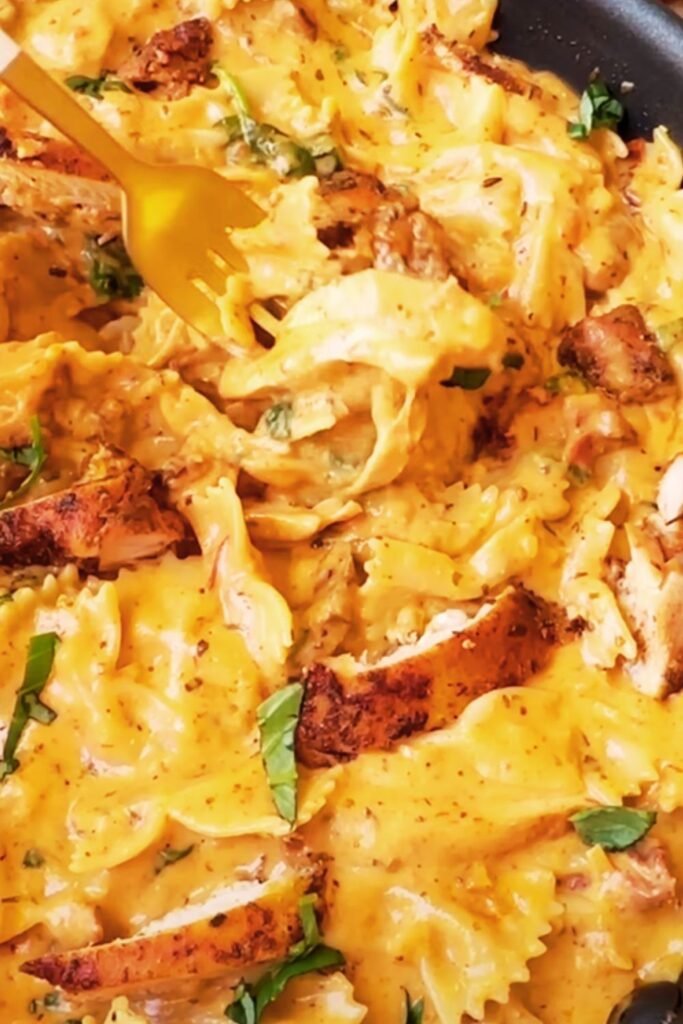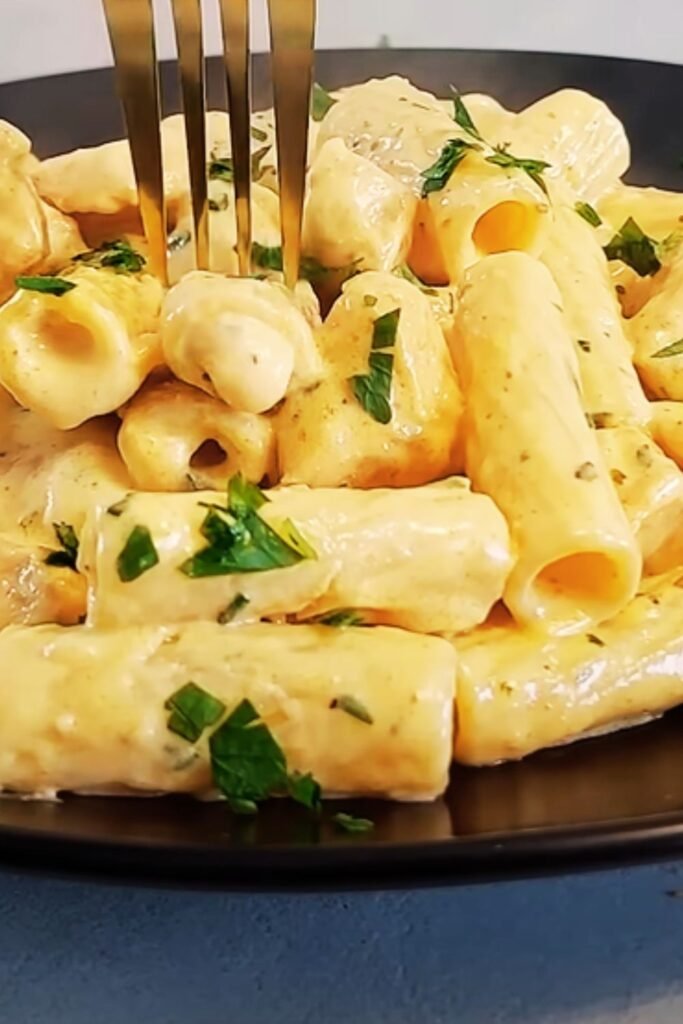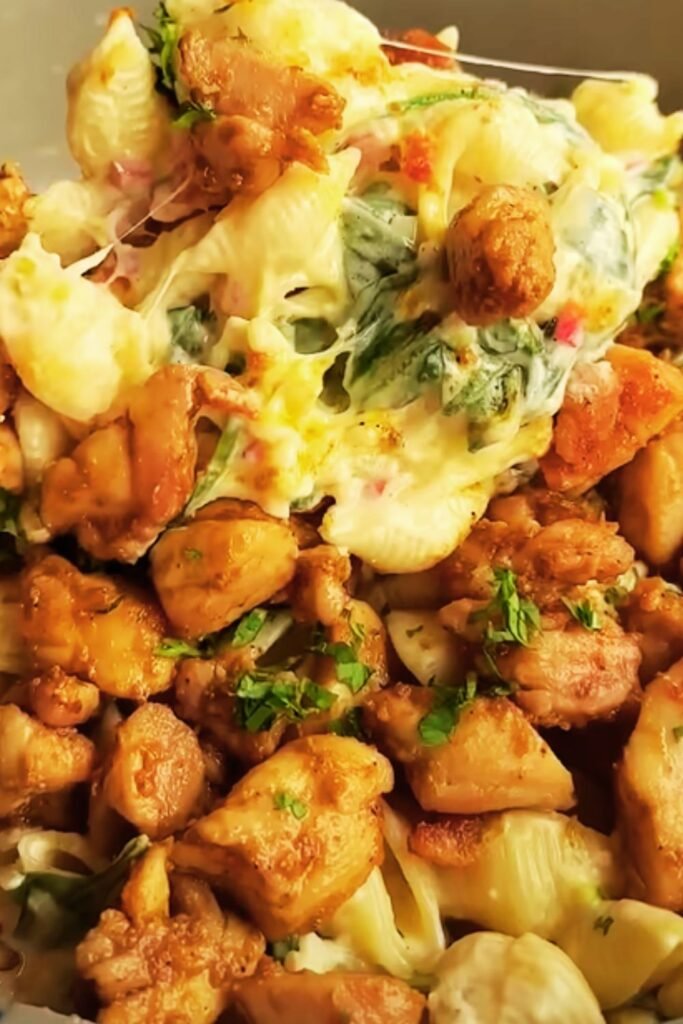There’s something magical about twirling perfectly cooked pasta around your fork, especially when it’s coated in a rich, creamy sauce and tender pieces of seasoned chicken. Italian Creamy Chicken Pasta has become my go-to recipe when I want to create something that feels both elegant and comforting. This dish combines the best of Italian flavors with the satisfying richness that makes every bite feel like a warm hug.
I’ve spent countless evenings perfecting this recipe, and I’m thrilled to share every secret I’ve learned along the way. Whether you’re cooking for a special someone, entertaining guests, or simply treating yourself to something extraordinary, this Italian Creamy Chicken Pasta will exceed your expectations.
What Makes This Recipe Special
My approach to Italian Creamy Chicken Pasta focuses on building layers of flavor that complement rather than compete with each other. The key lies in understanding how each ingredient contributes to the overall harmony of the dish. I use a combination of herbs, quality cream, and perfectly seasoned chicken to create a sauce that clings beautifully to every strand of pasta.
The beauty of this recipe is its versatility. I’ve served it at intimate dinner parties where guests couldn’t stop asking for the recipe, and I’ve also made it on busy weeknights when I needed something quick yet satisfying. The cooking process is straightforward, but the results taste like you’ve spent hours in the kitchen.
Essential Ingredients Breakdown
Protein Foundation
Chicken Breast: I always choose boneless, skinless chicken breasts for their tenderness and quick cooking time. The key is cutting them into uniform pieces to ensure even cooking.
Italian Seasoning: This blend typically includes oregano, basil, thyme, and rosemary. I sometimes make my own blend, but high-quality store-bought versions work perfectly.
Pasta Selection
Fettuccine: My preferred choice for this dish because its wide, flat surface holds the creamy sauce beautifully. However, penne, rigatoni, or even linguine work wonderfully too.
Creamy Sauce Components
Heavy Cream: The foundation of our luxurious sauce. I never substitute this with milk or half-and-half as it won’t achieve the same rich consistency.
Parmesan Cheese: Freshly grated Parmigiano-Reggiano makes all the difference. Pre-grated cheese simply doesn’t melt as smoothly or provide the same depth of flavor.
Garlic: Fresh garlic cloves, minced finely, create the aromatic base that makes this dish irresistible.
Flavor Enhancers
White Wine: A splash of dry white wine adds complexity and helps deglaze the pan, capturing all those beautiful browned bits from the chicken.
Sun-dried Tomatoes: These add bursts of concentrated tomato flavor and beautiful color contrast.
Fresh Spinach: Wilted spinach not only adds nutritional value but also provides a lovely color and subtle earthiness.

Detailed Ingredient Measurements
| Ingredient | Amount | Purpose | Substitution Options |
|---|---|---|---|
| Chicken Breast | 1.5 lbs | Main protein | Chicken thighs, turkey breast |
| Fettuccine Pasta | 12 oz | Base carbohydrate | Penne, rigatoni, linguine |
| Heavy Cream | 1 cup | Sauce base | No suitable substitution |
| Parmesan Cheese | 1 cup, grated | Flavor and thickening | Pecorino Romano |
| Garlic | 4 cloves | Aromatic base | Garlic powder (1 tsp) |
| White Wine | 1/3 cup | Deglazing and flavor | Chicken broth |
| Sun-dried Tomatoes | 1/2 cup | Concentrated flavor | Cherry tomatoes |
| Fresh Spinach | 3 cups | Nutrition and color | Arugula, kale |
| Olive Oil | 2 tbsp | Cooking medium | Vegetable oil |
| Butter | 2 tbsp | Richness | Additional olive oil |
| Italian Seasoning | 2 tsp | Flavor blend | Individual herbs |
| Salt | To taste | Seasoning | Sea salt, kosher salt |
| Black Pepper | To taste | Seasoning | White pepper |
Step-by-Step Cooking Instructions
Preparation Phase
I always start by organizing my workspace and preparing all ingredients. This approach, called mise en place, ensures smooth cooking without scrambling for ingredients mid-process.
First, I bring a large pot of salted water to boil for the pasta. The water should taste like seawater – this seasons the pasta from within. While waiting for the water to boil, I prepare my chicken by patting it dry with paper towels and cutting it into bite-sized pieces, roughly 1-inch cubes.
Seasoning the Chicken
I season the chicken pieces generously with salt, pepper, and half of the Italian seasoning. I let the chicken sit for about 10 minutes to absorb the flavors. This resting period makes a noticeable difference in the final taste.
Cooking the Pasta
Once the water reaches a rolling boil, I add the fettuccine and cook it according to package directions, but I always aim for al dente texture. Before draining, I reserve one cup of the starchy pasta water – this liquid gold will help bind our sauce later.
Creating the Chicken Base
In a large skillet over medium-high heat, I heat the olive oil until it shimmers. I add the seasoned chicken pieces in a single layer, being careful not to overcrowd the pan. Overcrowding leads to steaming rather than searing, which prevents the beautiful golden-brown color we’re after.
I cook the chicken for 5-6 minutes on the first side without moving it, allowing a golden crust to form. Then I flip and cook for another 4-5 minutes until the internal temperature reaches 165°F. Once cooked, I transfer the chicken to a plate and set aside.

Building the Sauce
In the same skillet, I reduce the heat to medium and add butter. Once melted, I add the minced garlic and sauté for about 30 seconds until fragrant. The key is not to let the garlic brown, as it becomes bitter.
Next, I add the white wine to deglaze the pan, scraping up any browned bits from the bottom. These bits are packed with flavor and will enhance our sauce. I let the wine reduce by half, which concentrates its flavor and cooks off most of the alcohol.
I then add the sun-dried tomatoes and remaining Italian seasoning, stirring for another minute to release their flavors. The aroma at this point is absolutely intoxicating.
Creating the Creamy Base
I pour in the heavy cream and bring it to a gentle simmer. I never let cream boil vigorously as it can curdle. Once simmering, I gradually add the grated Parmesan cheese, whisking constantly to prevent clumping. The sauce should be smooth and glossy.
Combining Everything
I return the cooked chicken to the skillet, followed by the drained pasta. Using tongs, I toss everything together, adding pasta water a little at a time until the sauce reaches the perfect consistency – it should coat the pasta without being too thick or thin.
Finally, I add the fresh spinach and toss until just wilted. The residual heat is perfect for this final step.
Nutritional Information
| Nutrient | Per Serving (6 servings) | % Daily Value |
|---|---|---|
| Calories | 485 | 24% |
| Total Fat | 22g | 34% |
| Saturated Fat | 12g | 60% |
| Cholesterol | 95mg | 32% |
| Sodium | 520mg | 22% |
| Total Carbohydrates | 48g | 16% |
| Dietary Fiber | 3g | 12% |
| Sugars | 4g | – |
| Protein | 32g | 64% |
| Vitamin A | 15% | 15% |
| Vitamin C | 8% | 8% |
| Calcium | 25% | 25% |
| Iron | 12% | 12% |
Cooking Tips and Techniques
Temperature Control
I’ve learned that maintaining proper heat levels is crucial for this dish. When cooking the chicken, medium-high heat creates the perfect sear. For the sauce, medium heat prevents the cream from breaking while allowing flavors to meld beautifully.
Pasta Water Magic
The starchy pasta water is my secret weapon for achieving the perfect sauce consistency. I add it gradually, usually 2-3 tablespoons at a time, until the sauce coats the pasta without being too thin or thick.
Timing Coordination
I always start the pasta water before beginning the chicken. This ensures everything finishes around the same time, preventing any component from getting cold while waiting for others.
Cheese Integration
When adding Parmesan, I remove the pan from heat temporarily and whisk vigorously. This technique prevents the cheese from seizing and creates a silky smooth sauce.
Common Mistakes to Avoid
Through my experience making this dish countless times, I’ve identified several pitfalls that can affect the final result:
Overcooking the Chicken: Chicken breast can become dry quickly. I always use a meat thermometer to ensure it reaches exactly 165°F.
Boiling the Cream: High heat can cause cream to curdle. I always maintain a gentle simmer and never walk away from the stove during this step.
Adding Cheese Too Quickly: Dumping all the Parmesan at once can create a lumpy sauce. I add it gradually while whisking constantly.
Overcooking the Pasta: Al dente pasta continues cooking slightly when tossed with the hot sauce. I always undercook it slightly in the initial boiling phase.
Not Reserving Pasta Water: This starchy liquid is irreplaceable for sauce consistency. I always remember to save at least a cup before draining.

Serving Suggestions and Pairings
Presentation Tips
I like to serve this pasta in warmed bowls to keep it at the perfect temperature. A sprinkle of fresh parsley and extra Parmesan on top adds visual appeal and extra flavor.
Bread Pairings
Crusty Italian bread or garlic bread complements this dish beautifully. The bread helps soak up any remaining sauce and adds textural contrast.
Salad Combinations
A simple arugula salad with lemon vinaigrette provides a fresh, peppery contrast to the rich pasta. I often add cherry tomatoes and pine nuts for extra flavor and crunch.
Vegetable Sides
Roasted asparagus, steamed broccoli, or sautéed zucchini work wonderfully alongside this pasta. These vegetables add color and nutritional balance to the meal.
Recipe Variations and Adaptations
Protein Alternatives
Shrimp Version: Replace chicken with large shrimp, cooking for 2-3 minutes per side until pink and cooked through.
Salmon Option: Use salmon fillets cut into chunks, cooking until flaky and opaque.
Vegetarian Adaptation: Omit the chicken and add extra vegetables like mushrooms, bell peppers, or roasted eggplant.
Pasta Modifications
Gluten-Free: Use gluten-free pasta, adjusting cooking time according to package directions.
Whole Wheat: Substitute whole wheat pasta for added fiber and nutrition.
Stuffed Pasta: Try with cheese-filled tortellini or ravioli for an extra indulgent version.
Sauce Variations
Mushroom Addition: Sauté sliced mushrooms with the garlic for an earthy flavor.
Herb Enhancement: Add fresh basil, oregano, or thyme for additional Italian flavors.
Spicy Kick: Include red pepper flakes or diced jalapeños for heat.
Storage and Reheating Instructions
Refrigerator Storage
I store leftover pasta in airtight containers in the refrigerator for up to 3 days. The sauce may thicken when cold, which is perfectly normal.
Reheating Methods
Stovetop Method: I reheat in a skillet over low heat, adding a splash of cream or pasta water to restore the sauce consistency.
Microwave Option: Heat in 30-second intervals, stirring between each interval and adding liquid as needed.
Oven Reheating: Cover with foil and heat at 350°F for 15-20 minutes, stirring halfway through.
Freezing Guidelines
While I don’t recommend freezing cream-based sauces as they can separate, the dish can be frozen for up to 1 month. Thaw completely before reheating and expect some texture changes.
Troubleshooting Common Issues
| Problem | Cause | Solution |
|---|---|---|
| Sauce is too thick | Too much cheese or insufficient liquid | Add pasta water gradually |
| Sauce is too thin | Not enough cheese or too much liquid | Simmer longer to reduce |
| Sauce is lumpy | Cheese added too quickly | Whisk vigorously, strain if needed |
| Chicken is dry | Overcooked | Use meat thermometer, don’t exceed 165°F |
| Pasta is mushy | Overcooked | Cook to al dente, continue cooking in sauce |
| Sauce separated | Cream boiled too vigorously | Maintain gentle simmer |
My Personal Story with This Recipe
This recipe holds a special place in my heart because it was one of the first dishes I successfully mastered when I started taking cooking seriously. I remember the first time I made it for my family – the kitchen filled with the most incredible aromas, and everyone gathered around asking what smelled so amazing.
Over the years, I’ve tweaked and refined this recipe based on countless attempts and feedback from friends and family. Each iteration taught me something new about balancing flavors, managing heat, and understanding how ingredients interact with each other.
The most rewarding aspect of this dish is watching people’s faces light up when they take their first bite. There’s something universally comforting about creamy pasta that brings people together and creates lasting memories around the dinner table.
Questions and Answers
Q: Can I make this recipe ahead of time? I don’t recommend making the complete dish ahead of time as cream sauces can separate when reheated. However, I often prepare the chicken and keep it in the refrigerator for up to 24 hours before finishing the dish.
Q: What’s the best way to prevent the sauce from curdling? The key is temperature control. Never let the cream boil vigorously – maintain a gentle simmer. Also, remove the pan from heat when adding cheese and whisk constantly to prevent clumping.
Q: Can I substitute the heavy cream with a lighter option? While you can use half-and-half, the sauce won’t be as rich and creamy. Milk doesn’t work well as it lacks the fat content needed for proper sauce consistency. For a lighter version, I recommend using half the amount of cream and adding some pasta water.
Q: How do I know when the chicken is properly cooked? The internal temperature should reach 165°F when measured with a meat thermometer. Visually, the chicken should be golden brown on the outside and white throughout with no pink areas.
Q: What should I do if my sauce is too salty? Add more cream or pasta water to dilute the saltiness. You can also add a pinch of sugar to balance the flavors. In the future, taste as you go and remember that Parmesan cheese is naturally salty.
Q: Can I use dried herbs instead of Italian seasoning? Absolutely! Use 1/2 teaspoon each of dried basil, oregano, and thyme. Fresh herbs work even better – use about three times the amount of fresh herbs compared to dried.
Q: Why is my pasta sticky after cooking? This usually happens when pasta is overcooked or not stirred enough during cooking. Make sure to stir occasionally while boiling and aim for al dente texture. Also, don’t rinse the pasta after draining as this removes the starch that helps sauce adhere.
Q: How can I make this dish spicier? Add red pepper flakes when cooking the garlic, or include diced jalapeños with the sun-dried tomatoes. You can also finish with a drizzle of chili oil or serve with crushed red pepper on the side.
Q: What’s the secret to getting the sauce to coat the pasta perfectly? The starchy pasta water is crucial – it helps bind the sauce to the pasta. Also, toss the pasta with the sauce while both are hot, and don’t be afraid to add pasta water gradually until you achieve the perfect consistency.
Q: Can I double this recipe for a larger crowd? Yes, but use a larger skillet or work in batches for the chicken to ensure proper searing. You may need to adjust cooking times slightly, and always taste and adjust seasoning when scaling up recipes.
This Italian Creamy Chicken Pasta represents everything I love about cooking – it’s approachable yet sophisticated, comforting yet elegant, and most importantly, it brings people together. Every time I make this dish, I’m reminded of why I fell in love with cooking in the first place. The combination of perfectly seasoned chicken, al dente pasta, and luxurious cream sauce creates a harmony that’s both satisfying and memorable.
I hope this recipe becomes as beloved in your kitchen as it has in mine. Take your time with each step, taste as you go, and don’t be afraid to make it your own. After all, the best recipes are the ones that evolve with your personal taste and bring joy to your table.